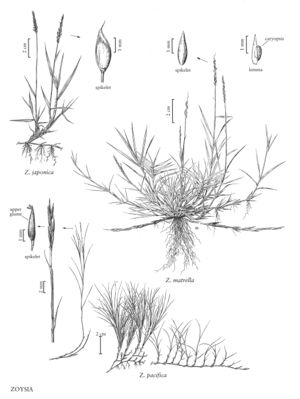Difference between revisions of "Zoysia japonica"
FNA>Volume Importer |
FNA>Volume Importer |
||
| Line 17: | Line 17: | ||
-->{{Treatment/Body | -->{{Treatment/Body | ||
|distribution=Md.;La.;Calif.;Ohio;Ala.;Tenn.;N.Y.;Va.;Ill.;Ind.;Ont.;Ky.;Fla. | |distribution=Md.;La.;Calif.;Ohio;Ala.;Tenn.;N.Y.;Va.;Ill.;Ind.;Ont.;Ky.;Fla. | ||
| − | |discussion=<p>Zoysia japonica was the first species of Zoysia introduced into cultivation in the United States, with the introduction of the cultivar 'Meyer' in the 1950s. It is the most cold-tolerant and coarsely textured of the three species that have been introduced to the Flora region, and is the only species that is currently available as seed in the United States. The other two species treated here can be established from seed, but there are currently no commercial sources of either one in the United States.</p> | + | |discussion=<p><i>Zoysia japonica</i> was the first species of <i>Zoysia</i> introduced into cultivation in the United States, with the introduction of the cultivar 'Meyer' in the 1950s. It is the most cold-tolerant and coarsely textured of the three species that have been introduced to the Flora region, and is the only species that is currently available as seed in the United States. The other two species treated here can be established from seed, but there are currently no commercial sources of either one in the United States.</p> |
|tables= | |tables= | ||
|references= | |references= | ||
| Line 38: | Line 38: | ||
|publication year= | |publication year= | ||
|special status= | |special status= | ||
| − | |source xml=https://jpend@bitbucket.org/aafc-mbb/fna-data-curation.git/src/ | + | |source xml=https://jpend@bitbucket.org/aafc-mbb/fna-data-curation.git/src/8f726806613d60c220dc4493de13607dd3150896/coarse_grained_fna_xml/V25/V25_929.xml |
|subfamily=Poaceae subfam. Chloridoideae | |subfamily=Poaceae subfam. Chloridoideae | ||
|tribe=Poaceae tribe Cynodonteae | |tribe=Poaceae tribe Cynodonteae | ||
Revision as of 16:35, 18 September 2019
Plants rhizomatous. Culm internodes 2-10 mm. Sheaths glabrous; ligules 0.05-0.25 mm; blades to 6.5 cm long, 0.5-5 mm wide, ascending, flat to loosely involute when fully hydrated, involute when stressed, surfaces glabrous or pilose. Peduncles exerted, extending 0.8-6.5 cm beyond the sheaths of the flag leaves. Racemes 2.5-4.5 cm, with 25-50 spikelets; pedicels 1.6-3.5 mm. Spikelets 2.5-3.4 mm long, 1-1.4 mm wide, ovate, awned, awns 0.1-1.1 mm. 2n = 40.
Distribution
Md., La., Calif., Ohio, Ala., Tenn., N.Y., Va., Ill., Ind., Ont., Ky., Fla.
Discussion
Zoysia japonica was the first species of Zoysia introduced into cultivation in the United States, with the introduction of the cultivar 'Meyer' in the 1950s. It is the most cold-tolerant and coarsely textured of the three species that have been introduced to the Flora region, and is the only species that is currently available as seed in the United States. The other two species treated here can be established from seed, but there are currently no commercial sources of either one in the United States.
Selected References
None.
